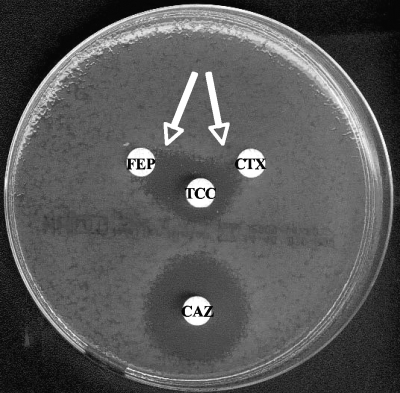β-Lactamase production is the main mechanism for β-lactam resistance in gram-negative rods. The more threatening β-lactamases that have successfully emerged and are believed to spread only in Enterobacteriaceae are CTX-M-type extended-spectrum β-lactamases (ESBLs) (5). The acquired β-lactamases with wide activity spectra that are important in Pseudomonas aeruginosa include class B metallo-β-lactamases (mostly IMP and VIM types and especially SPM-1 in Brazil) and class A ESBLs, particularly VEB-, PER-, and GES-type enzymes (3, 8, 9). However, a single CTX-M-1-producing P. aeruginosa isolate has been reported from The Netherlands (1), as well as CTX-M-2- and CTX-M-43-positive P. aeruginosa isolates in Bolivia (2). This study reports the identification of a CTX-M-2-producing P. aeruginosa strain isolated from a Brazilian teaching hospital.
During June 2005, a 63-year-old male patient with a recent hospitalization history was admitted to the intensive care unit for suspicion of pneumonia. He received ceftriaxone and clindamycin as first-line therapy. Four days later, he presented with septic shock and died. A blood culture grew P. aeruginosa (isolate P6208).
Isolate P6208 was resistant to all β-lactams tested, except imipenem and ceftazidime. A double-disk synergy test was performed with ticarcillin-clavulanic acid- and cefotaxime-cefepime-containing disks. The production of an ESBL was evidenced only under unusual conditions (with a distance between the disks of 1.5 cm center to center) (Fig. 1). Isolate P6208 was also resistant to fluoroquinolones, amikacin, gentamicin, and tobramycin and was susceptible to colistin. The MICs of imipenem, ceftazidime, cefepime, and cefotaxime determined by using Etest strips (AB Biodisk, Solna, Sweden) were 1 μg/ml, 2 μg/ml, >256 μg/ml, and >32 μg/ml, respectively.
FIG. 1.
Double-disk synergy test with blaCTX-M-2-positive P. aeruginosa clinical isolate P6208. Arrows indicate double-disk synergy. Abbreviations: CAZ, ceftazidime; TCC, ticarcillin-clavulanic acid; CTX, cefotaxime; FEP, cefepime.
HindIII-restricted total DNA from isolate P6208 as described previously (6) was used for cloning in pBK-CMV and was then transformed into Escherichia coli TOP10 and selected on agar plates containing ticarcillin (50 μg/ml) and kanamycin (30 μg/ml). The E. coli TOP10(p6208) recombinant strain displaying an ESBL phenotype was obtained. The sequencing of the 2,340-bp cloned DNA insert of recombinant plasmid p6208 identified a blaCTX-M-2 gene. It was preceded by an ISCR1 element located 498-bp upstream and followed by the qacEΔ1 gene cassette. This ISCR1-blaCTX-M-2 structure has already been identified in several enterobacterial species (7).
Plasmid extraction performed by the Kieser method (4) did not evidence any plasmid. In addition, repetitive attempts to transfer the blaCTX-M-2 gene by electroporation failed, using both E. coli TOP10 and P. aeruginosa PAO1 as recipient strains. Thus, the blaCTX-M-2 gene might be likely chromosomally located in isolate P6208.
This study identified a CTX-M-2-producing P. aeruginosa in Brazil. This finding is important since clinical laboratories may misidentify CTX-type enzymes in those nonfermenters, jeopardizing the choice of antimicrobial chemotherapy and the implementation of infection control measures. This report underlines that P. aeruginosa may become a hidden location for blaCTX-M genes.
Acknowledgments
This work was partially funded by grants from the Ministère de l'Education Nationale et de la Recherche (UPRES-EA3539) and Université Paris XI, France, and mostly by a grant from the European Community (LSHM-CT-2005-018705) and the INSERM. We are grateful to the Coordenação de Aperfeiçoamento de Pessoal de Nível Superior (CAPES) that conceded a PDEE grant to R.C.P. (protocol 3682/07-2), and to Conselho Nacional de Desenvolvimento Científico e Tecnológico (CNPq) for providing a researcher grant to A.C.G. (process number 307714/2006-3).
Footnotes
Published ahead of print on 17 February 2009.
REFERENCES
- 1.Al Naiemi, N., B. Duim, and A. Bart. 2006. A CTX-M extended-spectrum β-lactamase in Pseudomonas aeruginosa and Stenotrophomonas maltophilia. J. Med. Microbiol. 55:1607-1608. [DOI] [PubMed] [Google Scholar]
- 2.Celenza, G., C. Pellegrini, M. Caccamo, B. Segatore, G. Amicosante, and M. Perilli. 2006. Spread of blaCTX-M-type and blaPER-2 β-lactamase genes in clinical isolates from Bolivian hospitals. J. Antimicrob. Chemother. 57:975-978. [DOI] [PubMed] [Google Scholar]
- 3.Gales, A. C., L. C. Menezes, S. Silbert, and H. S. Sader. 2003. Dissemination in distinct Brazilian regions of an epidemic carbapenem-resistant Pseudomonas aeruginosa producing SPM metallo-β-lactamase. J. Antimicrob. Chemother. 52:699-702. [DOI] [PubMed] [Google Scholar]
- 4.Kieser, T. 1984. Factors affecting the isolation of CCC DNA from Streptomyces lividans and Escherichia coli. Plasmid 12:19-36. [DOI] [PubMed] [Google Scholar]
- 5.Pitout, J. D., and K. B. Laupland. 2008. Extended-spectrum β-lactamase-producing Enterobacteriaceae: an emerging public-health concern. Lancet Infect. Dis. 8:159-166. [DOI] [PubMed] [Google Scholar]
- 6.Poirel, L., I. Le Thomas, T. Naas, A. Karim, and P. Nordmann. 2000. Biochemical sequence analyses of GES-1, a novel class A extended-spectrum β-lactamase, and the class 1 integron In52 from Klebsiella pneumoniae. Antimicrob. Agents Chemother. 44:622-632. [DOI] [PMC free article] [PubMed] [Google Scholar]
- 7.Poirel, L., T. Naas, and P. Nordmann. 2008. Genetic support of extended-spectrum β-lactamases. Clin. Microbiol. Infect. 14:75-81. [DOI] [PubMed] [Google Scholar]
- 8.Walsh, T. R. 2008. Clinically significant carbapenemases: an update. Curr. Opin. Infect. Dis. 21:367-371. [DOI] [PubMed] [Google Scholar]
- 9.Weldhagen, G. F., L. Poirel, and P. Nordmann. 2003. Ambler class A extended-spectrum β-lactamases in Pseudomonas aeruginosa: novel developments and clinical impact. Antimicrob. Agents Chemother. 47:2385-2392. [DOI] [PMC free article] [PubMed] [Google Scholar]



